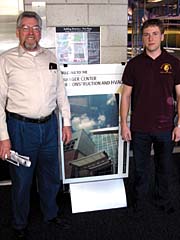The 75,000-square-foot building is an engineering marvel. The best way to describe it is to think of the model of the human body that many of you assembled as a kid (or maybe have assembled with your own children). I'm referring to the model that reveals all of the internal organs and bones, which can be viewed through the transparent skin and accessed by removing a piece in the lower abdomen area.
The model is a great teaching tool, and by examining it one can see how the internal body parts interact with each other and how the entire infrastructure is supported and protected by the hundreds of bones in the human body. It is both fun and educational.
So too is the Granger Center.
The building is one giant learning tool. All of the mechanical systems are exposed and color-coded. Students can trace the origins of each system and see how they interact with other building systems - from air handlers to ductwork to vents. Students also have access to four rooms (otherwise known as "environmental test chambers") where they can control the heating and cooling through a variety of different systems.
The laboratories are state of the art. Computers are set up at each workstation so students can test building controls and equipment from the comfort of their own ergonomically designed chair. Even distance-learning students can access the programs via the Internet and run simulated tests.

Up Close And Personal
While learning via the Internet is convenient and works for many people, and reading about the many amenities of the Granger Center can give one a taste of a world-class learning institution, nothing can be a substitute for visiting the building and talking with students and instructors.I have made the trek to Big Rapids many times in my role as a member of the college's HVACR Advisory Committee, a position I inherited from the former publisher of The News, Mike Miller. I remember the meetings in the old construction technology center and I remember watching the new Granger Center from the conception and planning stages through the construction and now to the completed project. Of course, many things have changed - and they have been all for the better.
For those of you who have visited the campus and the HVACR school prior to its new look, you are in for a big surprise. The building is not only a great learning center, it is a great representative of the importance of the HVACR trade. It should have quite an impact on young people who may be interested in a career in HVACR.
But the only way to feel the power and allure of this facility is to visit it in person. Mike Feutz, HVACR department chair, gets it.
He knows that in order to get young people excited about the trade, he has to get them up to the Granger Center. He knows that young people need to touch and feel the equipment, see its functionality and its importance to the lives of building occupants, and learn from the many students and teachers in the building how rewarding a career in HVACR can be.
Feutz has arranged for busloads of high school students to visit the facility. In fact, there are times he probably imagines himself as more of a tour guide than a teacher. But that's OK with him - anything to bring in young people and get them excited.
As Feutz puts it, it is not only important to get the young people involved, it is equally important to get parents, teachers, and counselors involved. With a little mentoring, the mentors could be shown that an HVACR career is viable and full of opportunities, with a solid foundation built through this learning facility.

More Than The Sum Of Its Parts
When I look at the learning opportunities available to young people today, I envision medical students working as interns in hospital emergency rooms and law students working as law clerks as they prepare for their careers. They have the opportunity to receive on-the-job training in real-life situations. Hopefully, they will get a glimpse of how different parts of the system interact - a real-life experience analogous to the see-through model.Any HVACR contractor or educator will tell you that an HVACR system is like a living thing. It is more than just metal and moving parts.
And that is the sense that students get when studying the multicolored systems in the Granger Center. As they are study the working systems, the learning process actually becomes fun.
Seeing the crowd of over 300 people at the building dedication earlier this month was a testament to the importance of the building to Ferris State and the community. It is also a testament to the Granger family, headed by Alton and Janice Granger.
The building not only bears the family name, but it is a symbol of the pride and professionalism of the Granger Construction Co., which built the facility. Several of the Granger children and grandchildren are alumni or are currently enrolled at Ferris State.
I think Chuck Matrosic, the interim dean of the Ferris State College of Technology, had the best description of the Granger Center.
He beamed, "It has the greatest ‘wow factor' of any building of its kind in the country."
The industry must attract bright young people in order to thrive in the future. The Granger Center and the staff members who walk its halls provide the excitement to do just that.
John Hall is business management editor. He can be reached at 248-244-1294, 248-362-0317 (fax), or johnhall@achrnews.com.
Publication date: 05/24/2004